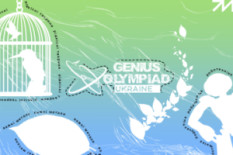 A student from the Junior Academy of Sciences made it into the TOP-50 best students in the world and is now competing for first place.
A student from the Junior Academy of Sciences made it into the TOP-50 best students in the world and is now competing for first place.
Yan Starodubets, a Junior Academy of Sciences student, was nominated by "Chegg.org" for the title of the world's best student this year. The Global Student Prize, with a prize of $100,000, is awarded to teenagers who have a tangible impact on education, the lives of their peers, and society as a whole. We interviewed Yan about his scientific journey, achievements, and participation in the competition. Let's read and wait for the boy's victory!
Read Yan's story in the JASmedia interview
 Ukrainian teenagers invented a drip holder for field conditions and won the "#CVIDOMI: rebuilding the country" hackathon.
Ukrainian teenagers invented a drip holder for field conditions and won the "#CVIDOMI: rebuilding the country" hackathon.
On June 17, the final of the hackathon for proactive teenagers, "#CVIDOMI: rebuilding the country," took place. Teams of students created innovative and scientific projects that will contribute to our victory and the future reconstruction of the country. The Junior Academy of Sciences organized the event with UNFPA Ukraine and the JAS "Ukrainian Future" business incubator. The winning team from the Kyiv region developed a 3D drip holder that is easy to use in field conditions.
Read the team's story in the JASmedia interview
 Kherson inventor Victoria Panchenko created an eco-invention that conquered the global scientific community.
Kherson inventor Victoria Panchenko created an eco-invention that conquered the global scientific community.
Bronze at the "Olympiad of Geniuses" in the USA, silver at "I-FEST" in Tunisia, and "INTARG" in Poland - student of the Junior Academy of Sciences, Victoria Panchenko from Nova Kakhovka in Kherson region, has gathered a plethora of awards with her eco-project! She created a plant-based filter for purifying water bodies from chemical pollutants, which can be used on an industrial scale.
Victoria shared the motives for starting her work in an interview with JASmedia:
"We lived in Nova Kakhovka - a city on the banks of the Dnieper River, and every year we faced a big problem when the river bloomed. There was an unpleasant odor, the water turned green, and swimming was impossible. However, there is a factory on the Dnieper where the water always remains clean. So, the river seems to be one, but in the riverbed, the water is dirty and green, while at the factories - it's clean. We became interested in why this happens, and from the works of hydrologists, we learned about the properties of plants that purify water. That's how we got the idea to use plants as a filter for water purification.
At first, my sister and I conducted experiments to see if plants could grow without soil. We created the first wooden structure for that. Later, I developed a pontoon from different materials and slightly modified the frame. Now it can withstand any plant's load.
Now I am working on getting my project implemented in practice."
Read Victoria's story in the JASmedia interview








